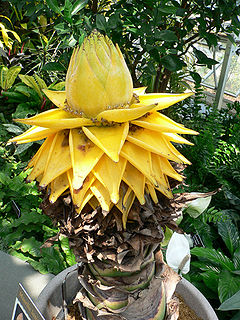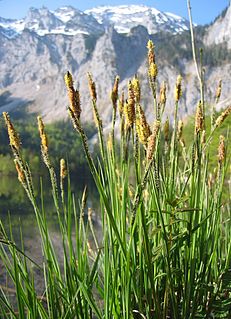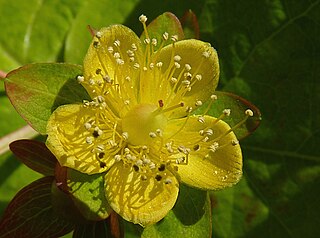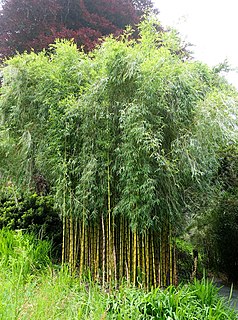
Salvia rosmarinus, commonly known as rosemary, is a shrub with fragrant, evergreen, needle-like leaves and white, pink, purple, or blue flowers, native to the Mediterranean region. Until 2017, it was known by the scientific name Rosmarinus officinalis, now a synonym.

The Royal Horticultural Society (RHS), founded in 1804 as the Horticultural Society of London, is the UK's leading gardening charity.

Kerria japonica, commonly known as Japanese rose or Japanese kerria, is a deciduous shrub in the rose family Rosaceae, native to China, Japan and Korea. It is named after William Kerr, who introduced the cultivar 'Pleniflora'. It is the sole species in the genus Kerria.

Parodia is a genus of flowering plants in the cactus family Cactaceae, native to the uplands of Argentina, Peru, Bolivia, Brazil, Colombia and Uruguay. This genus has about 50 species, many of which have been transferred from Eriocactus, Notocactus and Wigginsia. They range from small globose plants to 1 m (3 ft) tall columnar cacti. All are deeply ribbed and spiny, with single flowers at or near the crown. Some species produce offsets at the base. They are popular in cultivation, but must be grown indoors where temperatures fall below 10 °C (50 °F).

Musella lasiocarpa, commonly known as Chinese dwarf banana, golden lotus banana or Chinese yellow banana, is the sole species in the genus Musella. It is thus a close relative of bananas, and also a member of the family Musaceae. The plant is native to the Yunnan province in China, where it grows high in the mountains up to an altitude of 2500 m. It is known for its erect, yellow pseudostems, generally appearing during the second year of cultivation, that can last a few months. Just before opening, the yellow, flower-like pseudostem resembles a lotus - from which the plant gets one of its names.

Symphyotrichum ericoides, known as white heath aster, frost aster, or heath aster, is a species of flowering plant in the daisy family Asteraceae, native to much of central and eastern North America. It has also been introduced to parts of Europe and western Asia.

Parodia leninghausii is a species of South American cactus commonly found as a houseplant. Common names include Lemon Ball cactus, Golden Ball cactus and Yellow Tower cactus.

Parodia magnifica is a species of flowering plant in the cactus family Cactaceae, native to southern Brazil. One of several species called ball cactus, it grows to 7–15 cm (3–6 in) tall by 45 cm (18 in) broad, with heavily ribbed, spherical to columnar, spiny and hairy stems, bearing pale yellow flowers in summer. Its natural habitat is cool, dry temperate grassland at elevations of up to 800 m (2,600 ft). Populations are sparse and fragmented, and it has been designated as “Endangered” by the IUCN Red List.

Golden Noble is an old English cultivar of domesticated apple, which is especially used as a cooking apple, since it is resulting in a sweetish puree when cooked and is a good choice for apple sauce.

Celtica gigantea, commonly called giant feather grass, giant needle grass, or golden oats, is a species of flowering plant in the grass family Poaceae, native to southern Europe. It occurs in Spain and other Mediterranean countries. It is still widely referenced in the horticultural literature under its synonym Stipa gigantea.

Parodia scopa, the silver ball cactus, is a species of flowering plant in the cactus family Cactaceae, native to upland southern Brazil and Uruguay. It is a ball- or cylinder-shaped cactus growing to 5–50 cm (2–20 in) tall by 10 cm (4 in) broad, with a spiny, woolly crown and pale yellow flowers in summer.

Mammillaria bocasana is a species of cactus in the subfamily Cactoideae. It is often sold as a "powder puff" cactus, and also as a "Powder Puff Pincushion." The plant is protected from collecting in the wild in Mexico.

Carex elata, tufted sedge, is a species in the genus Carex, native to all of Europe, the Atlas Mountains of Africa, Turkey, Iran and Central Asia. It prefers to grow with its roots in water. Its cultivar 'Aurea' has gained the Royal Horticultural Society's Award of Garden Merit.

Eriocapitella × hybrida is a hybrid of flowering plants in the buttercup family Ranunculaceae. The parents of the hybrid are E. japonica and E. vitifolia. Cultivars of the hybrid are commonly known as Japanese anemone hybrids.

Hypericum × inodorum is a nothospecies of flowering plant in the family Hypericaceae which is native to France, Italy, and Spain, and has been introduced to the United Kingdom, Ireland, Portugal, Switzerland, Chile, Mexico, New Zealand, and Indonesia. The nothospecies is a fertile hybrid of Hypericum androsaemum and Hypericum hircinum, and its hybrid name inodorum derives from the Latin for "odorless". Its cultivar 'Wilhyp' has gained the Royal Horticultural Society's Award of Garden Merit.

Trollius chinensis, the Chinese globeflower, is a species of flowering plant in the family Ranunculaceae, found from southern Siberia to the southern Russian Far East, Sakhalin, the Kurils, Mongolia, Korea, and northern China. Its cultivar 'Golden Queen' has gained the Royal Horticultural Society's Award of Garden Merit.

Parodia crassigibba, the green tomato cactus, is a species of cactus in the genus Parodia, native to Rio Grande do Sul state in southern Brazil. It has gained the Royal Horticultural Society's Award of Garden Merit as a houseplant.

Chusquea gigantea is a species of bamboo in the family Poaceae, native to central Chile. A clumping bamboo with solid stems, it has gained the Royal Horticultural Society's Award of Garden Merit.

Parodia concinna, the sun cup, is a species of cactus in the genus Parodia, native to southern Brazil and Uruguay. It has gained the Royal Horticultural Society's Award of Garden Merit.



















